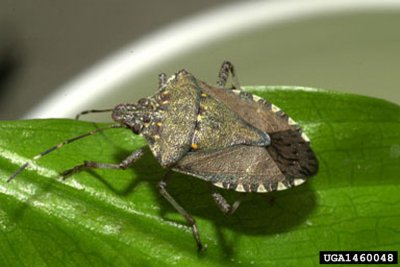
The brown marmorated stink bug is indigenous to Asia and is considered an agricultural pest in Japan. The insects have been found in trees and in houses, where they produce a pungent, malodorous chemical. The insect can be an agricultural pest, threatening apples, pears, peaches, figs, mulberries, citrus, persimmon and soybeans. (Photo: invasive.org)
ANNAPOLIS (Sept. 15, 2010) – The brown marmorated stink bug (Halyomorpha halys), a native of Asia, is emerging as a major nuisance to homeowners and a devastating pest to orchardists and potentially to soybean growers in Maryland. Residents across Maryland are reporting large numbers of the insect in and around their homes and gardens and are seeking relief. The Maryland Department of Agriculture (MDA) recommends contacting the University of Maryland Extension Home and Garden Information Center (HGIC) to learn more about the stink bug and ways to exclude them from buildings before contacting a licensed pest control company. Farmers will want to work with their University of Maryland Extension agents and crop advisors to devise strategies to control the stink bug and limit impact on other beneficial insects. The stink bug does not bite or sting and can’t harm humans or homes.
“These particular stink bugs are fairly new to Maryland and are making themselves known to residents and farmers in large numbers and in unpleasant ways,” said Agriculture Secretary Buddy Hance. “While this is not a regulated pest for which MDA is able to run a control program, we do want to point people in the right direction for information and assistance. The University of Maryland Extension’s Home and Garden Information Center is the best source of information for non-farming residents and backyard gardeners. While the University of Maryland Extension along with other research institutions are working to find solutions for farmers, there is currently no quick answer to control this new pest in agricultural settings. It is very trying for many farmers who have seen significant crop losses this year.”
Native to Asia, the brown marmorated stink bug was first identified in Allentown, Pa. in 2001, though sightings may date back to 1996. Many sources of information maintain that it is just a nuisance pest and mostly to home owners, but not to commercial fruit or vegetable growers. That has all changed this year in Maryland with significant damage to commercial growers. It is a significant pest of fruit trees such as apples and peaches, and legumes such as soybeans, with extreme damage being reported in Western and Central Maryland orchards for the first time this year. Many backyard gardeners have noticed the stink bug on tomatoes, peppers, and raspberries for example. A number of tree species and ornamental plants also serve as hosts.
According to the UME HGIC, the brown marmorated stink bug adults emerge from overwintering sites during late May through the beginning of June. They mate and lay eggs from June through August and probably into September. The eggs hatch into small black and red nymphs that go through five molts throughout July and August. Adults begin to show in mid-August. Their flights for overwintering sites start in mid-September and continue through October. The insects will start heading indoors to over winter as the weather cools.
For homeowners, the HGIC recommends preventing the insect from coming in the home by sealing up cracks with caulk, use weather stripping around doors and windows, remove window air conditioners, close all possible entry points. Once the insect is indoors, residents can vacuum them up and place in an outdoor trash receptacle. It should be noted that if many of them are squashed or pulled into a vacuum cleaner, their odor can be quite strong.
There are no chemical recommendations currently available for home use to control brown marmorated stink bug populations. Because these pests are so difficult to control, there have been situations in which pesticides not intended for residential applications have been improperly used or applied at greater rates than the label allows. While controlling these insects is challenging, consumers should never use, or allow anyone else to use, a pesticide indoors that is intended for outdoor use, as indicated on the label. Using the wrong pesticide or using it incorrectly can cause illness in people and pets. It can also make homes unsafe to live in – and may not solve the pest problem. For heavy infestations outdoors, contact a pest control professional.
RELATED INFORMATION:
-- University of Maryland Home and Garden Information Center (residents and backyard gardeners) – www.hgic.umd.edu or toll free from Maryland 1-800-342-2507
-- University of Maryland College of Agriculture and Natural Resources, Extension www.extension.umd.edu
-- Maryland Department of Agriculture Pesticide Regulation Section www.mda.state.md.us/plants-pests/pesticide_regulation/
-- Rutgers University - njaes.rutgers.edu/stinkbug/
-- Penn State University - ento.psu.edu/extension/factsheets/brown-marmorated-stink-bug
-- Northeastern IPM Center - www.ncipmc.org/alerts/stinkbug_alert.pdf
Source: Maryland Dept. of Agriculture


